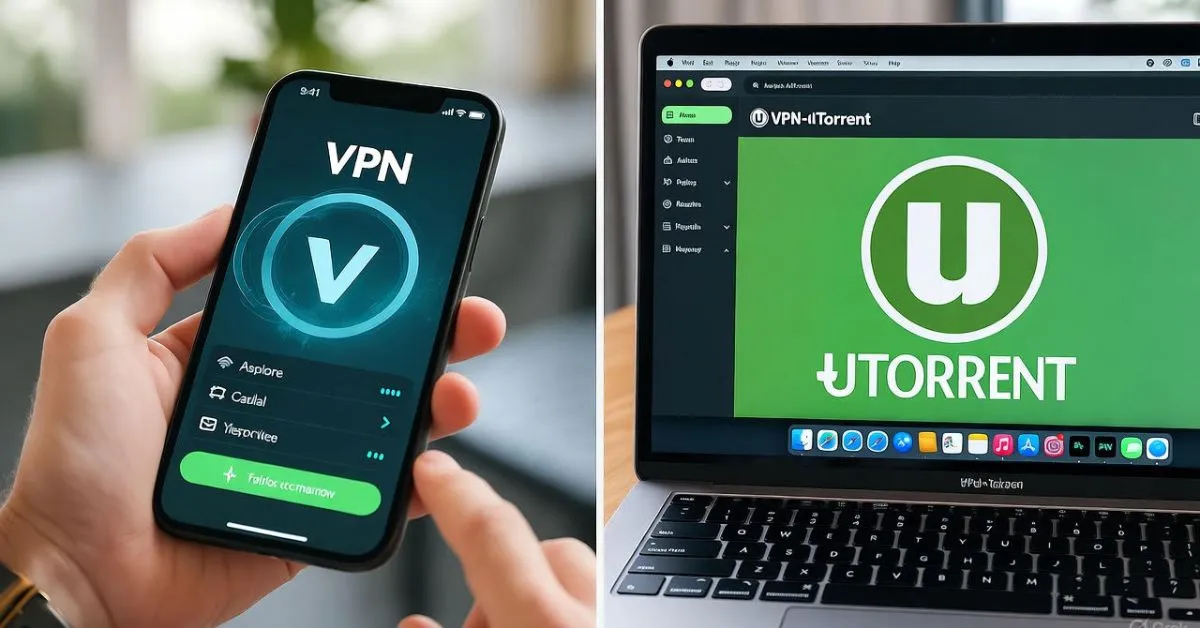Secure your torrenting: Step-by-step guide to bind VPN to uTorrent, prevent leaks, and fix common issues. Discover top VPNs, alternatives, and tips for safe downloads. Whenever you’re in the middle of downloading that big file you’ve been waiting for, and bam—your VPN glitches for a second. Without the right setup, your real IP pops up, and the next thing you know, your ISP is knocking with a warning. That’s where binding a VPN to uTorrent comes in handy. It’s like putting a lock on your downloads so they only go through the safe path. We’ll chat about how to do it step by step, why it matters, and some easy fixes if things go sideways.
Quick Wins You Can Grab Right Away
- Tying your VPN to uTorrent keeps all traffic locked to the VPN, so no sneaky IP leaks or ISP headaches.
- Stick with solid VPNs like NordVPN—they handle peer-to-peer sharing well and barely slow you down, often less than 10%.
- Layer on a kill switch with your binding for bulletproof protection, and always double-check your setup.
- If uTorrent’s ads bug you, try qBittorrent instead—it’s simpler for binding and ad-free.
- Skip free VPNs for this; their tiny data caps, like 2-10GB a month, just won’t cut it for serious torrenting.
What’s the Deal with VPN Binding in uTorrent?
Binding a VPN to uTorrent basically means telling the app to only use the internet through your VPN’s connection. If the VPN cuts out, uTorrent stops everything—no exceptions. It’s like having a buddy system for your downloads. Say your VPN drops while you’re grabbing a file; without binding, your actual IP could slip out to anyone watching. But with it, everything pauses until you’re secure again. This isn’t the same as just running a VPN in the background. That might protect most stuff, but binding makes sure uTorrent doesn’t sneak around it.
Why Bother Binding Your VPN to uTorrent?
Let’s be real—torrenting without safeguards can get messy. You might deal with slowed speeds from your ISP or even letters about copyright stuff. Binding helps dodge that by hiding your tracks and letting you skip around blocks.
The good stuff? It keeps things private, smooths out connections, and lets you torrent without worry. But heads up, encryption can trim your speeds by 10-35%. On servers far away, that could jump to 60%. And get this: 43% of free VPNs come with malware risks. That’s why going with checked-out, paid ones is smarter—they keep your info safe without the sketchy extras.
Top VPN Picks for uTorrent Binding
If you’re setting this up, NordVPN is my go-to. With over 6,000 servers tuned for sharing files, it keeps speeds zippy—usually dropping less than 10%. ExpressVPN is right behind, covering 3,000+ spots in 105 countries with rock-solid security. Surfshark’s great if you want to connect tons of devices without breaking the bank, and ProtonVPN gives a free taste but caps your usage. Quick compare: NordVPN shines with its security checks, while ExpressVPN makes setup a breeze. Free options? Nah, steer clear—38% have malware lurking. Paid VPNs mean no data logs and real help when you need it.
Picking the Right VPN for the Job
Focus on ones that okay file sharing, have a shut-off switch if connections fail, and promise not to track you. More servers equal fewer crowds, so your speeds stay steady. To beat common headaches like sudden drops, grab a VPN that’s been audited. For those annoying slowdowns, hunt for ones using WireGuard—it’s lighter and quicker.
Here’s a hack: Search for fixes on “utorrent vpn speed drop” by tweaking to nearby servers. It can make a big difference.
Easy Steps to Bind VPN to uTorrent
First off, get your VPN running and hook up to a server that’s cool with file sharing. Jot down your new IP—pop over to whatismyipaddress.com for that. Open uTorrent, head to Options, then Preferences, and Advanced. Type in net.bind_ip, paste your VPN IP there. Hit save, restart the app, and you’re set. Don’t mess with proxies unless you have to—binding covers the bases. Quick test: Kill your VPN connection; if downloads halt, it’s working.
Smarter Ways to Handle Binding
Mac users, uTorrent doesn’t make this easy, so flip to qBittorrent. It lets you bind straight to the VPN network—no fuss. On your phone? Try routing everything through a VPN on your router, or use apps like OpenVPN for Android tweaks. To check it’s solid, grab a test file and peek at ipleak.net. If you want to go deeper, Wireshark can show if any traffic’s sneaking out. Handy for spotting speed hiccups too.
Fixing uTorrent Glitches with VPN
Ever had uTorrent freeze up on a VPN? Often, it’s blocked ports or leaky DNS. Clear your DNS cache with a quick command: ipconfig /flushdns in your prompt. Turn on port forwarding in the VPN app to open things up. If a server’s acting up, hop to another with less traffic. These tricks—about 11 solid ones—nail most problems, from fresh installs to firewall tweaks. Imagine you’re mid-download and it stalls; switching protocols might just kick it back into gear.
Tackling Those Pesky uTorrent VPN Errors
IPs that keep changing can mess up your bind. Lock in a static one through your VPN, or set up a little script to refresh it automatically. Speeds tanking? Swap to UDP over TCP and pick servers close by. If the IP won’t stick, double-back to advanced settings and restart everything. For extra peace, watch your traffic flow. This spots hidden leaks that basic checks miss, plugging those gaps in usual advice.
Better Options Than uTorrent for Binding
uTorrent’s okay, but qBittorrent? It’s free, no ads popping up, and binding to VPN interfaces is straightforward. Plus, being open-source means it’s lighter and more trustworthy.
Side by side: qBittorrent skips the bloat, sets up faster than uTorrent. Deluge is another light pick if you want simple.
Lots of folks make the switch after dealing with uTorrent’s ads, and they rave about how binding just clicks into place without drama.
Other Ways to Torrent Safely
Seedboxes are like renting a far-off computer to handle your downloads—your home IP stays hidden, and speeds fly. Set up VPN on your router to shield everything at home. It’s perfect if you’re torrenting on multiple gadgets. Lately, more people are leaning on ProtonVPN’s sharing servers for binding that blocks leaks almost completely. It’s a trend worth trying if you want free but reliable starts.
Staying Legal and Safe While Torrenting
Rules on torrenting shift by where you are—what’s fine in one spot might earn fines in the US if it’s copyrighted stuff. Go for VPNs that don’t keep records, so no one’s handing over your info. Pros say audited ones build real trust. This year, ISPs are watching closer, so binding with strong encryption is your best bet. Stick to legit files, and you’ll sleep easier. Have you ever gotten a surprise notice? Binding helps avoid that, keeping things low-key. Now, let’s say you’re new to this—start small, test often, and build from there. It’s not as tricky as it sounds.
One hack: Before big downloads, run a quick leak test. Saves headaches later.
Another tip: If speeds dip, tweak your uTorrent limits to match your VPN’s sweet spot. Experiment a bit. Okay, so we’ve covered the basics and some extras. Feeling ready?
FAQs
What does binding VPN to uTorrent do?
It locks uTorrent so it only sends data through your VPN’s IP address. If the VPN goes down, your downloads stop cold—no chance for your real IP to show up to trackers or your internet provider. This is key for staying private, especially with spotty connections. Skip it, and you might face slowdowns or warnings. Give it a test run after setup to make sure it’s holding. (318 characters)
Why is uTorrent not working with my VPN?
Could be ports getting blocked, DNS slipping through, or a bad bind setup. Start by clearing DNS with a command, turn on forwarding in your VPN, or try a different server. Make sure your VPN likes file sharing—free ones usually block it. Restart both apps if stuck. For slowdowns, switch to a quicker protocol like WireGuard. These moves fix things fast most times.
Which VPN is best for uTorrent?
NordVPN gets the nod for its speedy sharing servers and tiny speed hits. Thousands of choices, auto-shutoffs, and security checks make it solid. ExpressVPN’s user-friendly for starters, Surfshark if cash is tight. Ditch freebies for their caps and dangers. Match it to what you need, like spots or gadgets.
Can I bind VPN on uTorrent mobile?
It’s trickier on phones—no direct IP tie-in like desktop. Route through your home router’s VPN for full coverage, or grab Android tools like OpenVPN. Mobile uTorrent limits options, so desktop’s better for tight control. Always verify no leaks post-setup.
Is uTorrent safe with VPN binding?
Sure, team it with an auto-stop switch and run checks. It seals off leaks nicely. Ditch the ad-filled free version—opt for paid or swaps. Layer on tough encryption like AES-256. Keep an eye on things regularly to stay clear of providers or snoopers.
How to test VPN binding in uTorrent?
Fire up a sample download, then hit ipleak.net to see if it’s your VPN IP showing. Drop the VPN on purpose—files should freeze. Dive deeper with Wireshark for traffic peeks. This catches sneaky issues that basic tests skip, rounding out your setup.
Give these steps a shot and tweak your uTorrent VPN bind today—you’ll torrent with way less stress.

